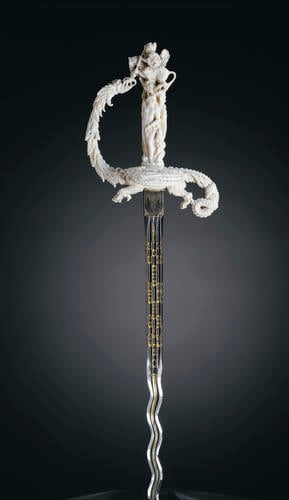Dress sword mid-seventeenth century?
Ivory and steel | 96.5 cm (whole object) | RCIN 67142
-
The elaborately carved hilt of this sword depicts the rescue of Andromeda by Perseus, who descends on his winged horse Pegasus to destroy the fierce dragon tormenting his captive. It resembles ivory carvings produced at Maastricht in Holland during the mid-seventeenth century, when ivory was being imported in quantity by the Dutch East India Company. The hilt consists of four separate pieces: the pommel and grip (with Perseus and the chained Andromeda), the knuckle-guard (with the long neck and mouth of the dragon); the quillon-block and rear quillon (the dragon's back and tail); and the somewhat diminished shells, carved with the dragon's wings and feet. A.V.B. Norman related it in style to the work of Maastricht carvers, in particular on the stocks of a pair of pistols in the Wallace Collection. The wavy-edged blade, which was added after the hilt entered George IV's collection in 1820, is etched on one side with the half-length figure of a woman in the fashionable dress of around 1700, and on the other side with a bust of a man, similarly dressed. It was probably made in Germany around that date. The blade was waved during forging rather than by the more usual method of filing the edges of a conventional blade. Catalogue entry from Royal Treasures, A Golden Jubilee Celebration, London 2002
Provenance
The hilt: Rundell, Bridge and Rundell; from whom bought by George IV, 1802 (£21, invoice dated 9th July); the blade added (bill untraced). -
Creator(s)
(retailer/maker)(place of production) -
Medium and techniques
Ivory and steel
Measurements
96.5 cm (whole object)
80.5 cm (blade length)









